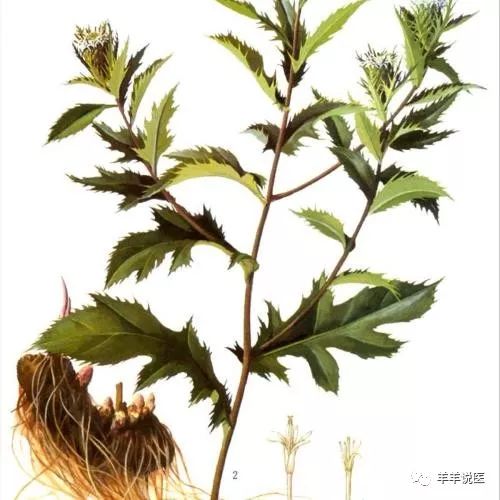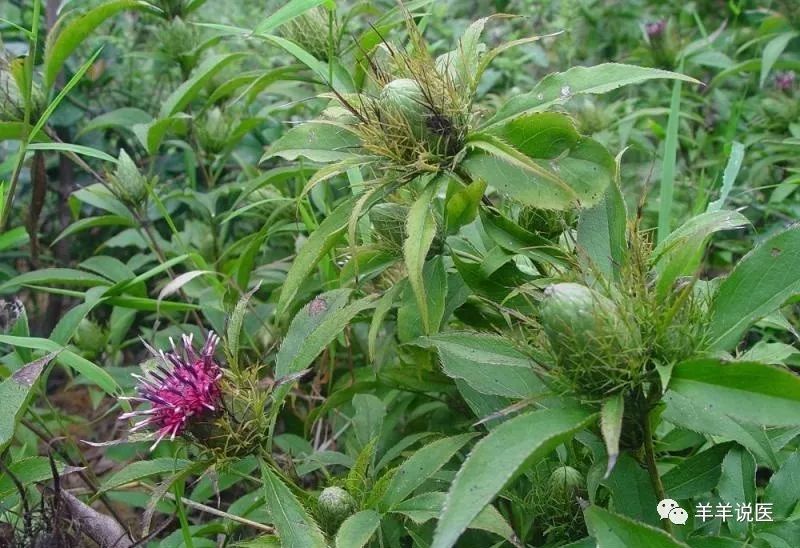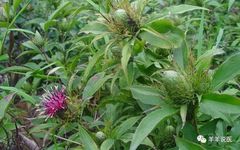
Cang Zhu (Atractylodes) is also known as Chi Zhu, Ma Ji, Qing Zhu, Xian Zhu, and Qiang Tou Cai. It is the dried rhizome of the Asteraceae plant, either Mao Cang Zhu (Atractylodes macrocephala) or Bei Cang Zhu (Atractylodes lancea). This is a perennial herbaceous plant. It is harvested in spring and autumn, cleaned of soil, dried, and the fibrous roots are removed.
This species has many medicinal names, such as Han Cang Zhu and Mao Zhu (Mao Cang Zhu); however, these names can generally be divided into two main categories: Bei Cang Zhu from the north and Nan Cang Zhu from the south.
1. Mao Cang Zhu is also known as Nan Cang Zhu, primarily produced in Jiangsu, Hubei, and Anhui provinces, with the best quality coming from the Mao Mountain area in Jiangsu, hence the name Mao Cang Zhu. It has an irregular, bead-like or nodular cylindrical shape, slightly curved, occasionally branched, measuring 3 to 10 cm in length and 1 to 5 cm in diameter. The surface is gray-brown, with wrinkles, transverse grooves, and residual fibrous roots, and the top has stem scars or remnants of the stem base. It is solid, with a cross-section that is yellow-white or gray-white, scattered with numerous orange-yellow or brown-red oil chambers, which can produce white needle-like crystals upon exposure. It has a unique fragrance, with a slightly sweet, spicy, and bitter taste.
2. Bei Cang Zhu is primarily produced in Hebei, Shanxi, Inner Mongolia, Liaoning, and Heilongjiang provinces. It has a lumpy or nodular cylindrical shape, measuring 4 to 25 cm in length and 1 to 10 cm in diameter. The surface is black-brown, turning yellow-brown when the outer skin is removed. It is relatively loose, with a cross-section scattered with yellow-brown oil chambers. The aroma is milder, with a spicy and bitter taste. Bei Cang Zhu is lighter and less dense than Mao Cang Zhu, with fewer oil glands, and does not produce white crystalline frost upon cutting, resulting in generally lower quality compared to Mao Cang Zhu.
In addition to the mainstream Mao Cang Zhu and Bei Cang Zhu, some regions also use a related plant, Dong Cang Zhu (also known as Guan Cang Zhu), as a substitute for medicinal use.

It has a spicy and bitter taste, and is warm in nature. It enters the Spleen, Stomach, and Liver meridians. It dries dampness and strengthens the Spleen, dispels wind and cold, brightens the eyes, and eliminates foulness. It is used for damp obstruction in the middle jiao, abdominal distension, fatigue, lack of appetite, phlegm retention, diarrhea, edema, heavy pain in the head and body, beriberi, limb joint pain, rheumatic pain, wind-cold colds, night blindness, and blurred vision. It should not be taken in excess and is contraindicated with sour foods. Pregnant women should avoid it.
Modern Pharmacological Research
1. Cang Zhu has anti-gastritis and anti-ulcer effects; it regulates gastrointestinal motility.
2. Cang Zhu glycosides can lower blood sugar levels while inhibiting glycogen production, reducing muscle and liver glycogen reserves and oxygen consumption, but increasing blood lactate levels.
3. Cang Zhu, when combined with other Chinese herbs like Ai Ye (Mugwort), has a bactericidal effect against various cocci, bacilli, and viruses.
4. Cang Zhu also has liver-protective, bile-expelling, diuretic, anti-hypoxia, and vasodilatory effects. It can significantly inhibit the growth of esophageal cancer cells.

In ancient times, Bai Zhu and Cang Zhu were not distinguished; for example, in Zhang Zhongjing’s medical texts, they were collectively referred to as “Zhu”. Later, Tao Hongjing discovered that there are two types of “Zhu,” which not only have distinct plant forms but also different functions, leading to their gradual separation.
Cang Zhu is the dried rhizome of the Asteraceae plant Mao Cang Zhu or Bei Cang Zhu, while Bai Zhu is the dried rhizome of the Asteraceae plant Bai Zhu (Atractylodes macrocephala). Bai Zhu has a predominantly white cross-section, while Cang Zhu is more bluish-black. Cang Zhu is mainly produced in Jiangsu’s Mao Mountain area, hence the name; Bai Zhu is primarily produced in Zhejiang’s Yuqian, also known as Yuzhu.
Bai Zhu has a bitter and sweet taste, is warm in nature, and enters the Spleen and Stomach meridians. It strengthens the Spleen and benefits Qi, dries dampness and promotes urination, stops sweating, and stabilizes the fetus. It is used to treat Spleen deficiency with poor appetite, abdominal distension, diarrhea, phlegm dizziness, edema, spontaneous sweating, and fetal restlessness. The typical dosage is 6–12g.
Cang Zhu has a spicy and bitter taste, is warm in nature, and enters the Spleen, Stomach, and Liver meridians. It has the effects of drying dampness, strengthening the Spleen, dispelling wind and cold, and brightening the eyes. It is used to treat abdominal distension, diarrhea, edema, beriberi, rheumatic pain, wind-cold colds, and night blindness. The decoction dosage is 3–9g.
Bai Zhu is classified as a Qi-tonifying herb in traditional Chinese medicine, known as the primary herb for Spleen tonification, while Cang Zhu is classified as a damp-transforming herb. Bai Zhu primarily benefits Qi and strengthens the Spleen, often used for Spleen deficiency with dampness; Cang Zhu focuses on bitter warmth to dry dampness and strengthen the Spleen, suitable for cases of internal damp obstruction leaning towards excess.


